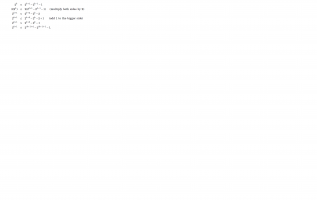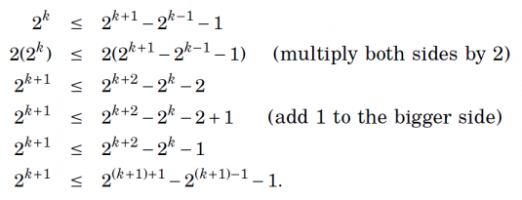Hello everyone. Firstly, sorry for my english. Secondly, I have got question about inequalities shown in attached picture. Are inequalities in 4th and 5th line proper (4th is more important for me)? If right side is equal left adding 1 to right side should make right side bigger than left. If right side is bigger than left adding 1 should remain right side bigger. So, in both cases right side should be bigger than left and shouldn't in 4th line be 2^(k+1) < 2^(k+2)-2^k-2+1?
You are using an out of date browser. It may not display this or other websites correctly.
You should upgrade or use an alternative browser.
You should upgrade or use an alternative browser.
Proof with inequality
- Thread starter Polish89
- Start date
Dr.Peterson
Elite Member
- Joined
- Nov 12, 2017
- Messages
- 16,092
Hello everyone. Firstly, sorry for my english. Secondly, I have got question about inequalities shown in attached picture. Are inequalities in 4th and 5th line proper (4th is more important for me)? If right side is equal left adding 1 to right side should make right side bigger than left. If right side is bigger than left adding 1 should remain right side bigger. So, in both cases right side should be bigger than left and shouldn't in 4th line be 2^(k+1) < 2^(k+2)-2^k-2+1?
Yes, that's valid. In effect, you are adding the inequality on the third line and the inequality [imath]0\le1[/imath], which is valid.
You could indeed make a stronger statement by adding [imath]0<1[/imath]. But in the context, which I suspect to be an induction proof, that wouldn't help. In a proof, what you do has to be both valid and useful.
Hmm. I don't understand. Isn't "that wouldn't help" in the context of proof inappriopriate? In my opinion we shouldn't say that something in proof is inappriopriate, but that proof is wrong (it sounds a bit like adjusting to our outcome, I mean doing everything to show that our proof is good). Why we doesn't treat this inequality like normal inequality? I mean, f.ex if we have got x<=y and add 1 to right side we have got x<y. Or I am wrong? Isn't the proof whole and the part where we have got calculations shouldn't be guided by mathematical rules like in my example in preceding sentence?
Yes, that's valid. In effect, you are adding the inequality on the third line and the inequality [imath]0\le1[/imath], which is valid.
You could indeed make a stronger statement by adding [imath]0<1[/imath]. But in the context, which I suspect to be an induction proof, that wouldn't help. In a proof, what you do has to be both valid and useful.
Dr.Peterson
Elite Member
- Joined
- Nov 12, 2017
- Messages
- 16,092
I didn't say anything wasn't appropriate; but it's true that something can be valid (that is, not wrong), but not the best choice for the purpose.Hmm. I don't understand. Isn't "that wouldn't help" in the context of proof inappriopriate? In my opinion we shouldn't say that something in proof is inappriopriate, but that proof is wrong (it sounds a bit like adjusting to our outcome, I mean doing everything to show that our proof is good).
Since you didn't show the context, I can't say anything about the overall proof you are asking about! Why have you not answered our implied request for that information? That's necessary in order to fully discuss this.
If we are right that what they want to show (within a bigger proof) is that
then if you said instead that
you would need to add another step, stating that the latter implies the former! So, again, it wouldn't be false, but would be a bad choice. You seem to be saying that you should never say the first line, but only the second; I am saying that both are valid inferences, but presumably the second is the one needed by the context.
No, if you start with [imath]x\le y[/imath] and add 1 to the right side, you get [imath]x\le y+1[/imath], which is not equivalent! Probably what you mean to say is that if [imath]x\le y[/imath], then [imath]x<y+1[/imath]. That's true, as I already said. But it is also true that [imath]x\le y+1[/imath], just as if I am less than than 6 feet tall, it is also true that I am no more than 6 feet tall.Why we doesn't treat this inequality like normal inequality? I mean, f.ex if we have got x<=y and add 1 to right side we have got x<y. Or I am wrong? Isn't the proof whole and the part where we have got calculations shouldn't be guided by mathematical rules like in my example in preceding sentence?
Again, what I'm saying is that there can be many things that are true, but in a proof some of them may contribute to the proof, others may not contribute, and others may contribute but not be the most useful thing to say at that point.
PLEASE show us the context, and either confirm or deny our guess that this is part of an inductive proof!
You ARE wrong.Hmm. I don't understand. Isn't "that wouldn't help" in the context of proof inappriopriate? In my opinion we shouldn't say that something in proof is inappriopriate, but that proof is wrong (it sounds a bit like adjusting to our outcome, I mean doing everything to show that our proof is good). Why we doesn't treat this inequality like normal inequality? I mean, f.ex if we have got x<=y and add 1 to right side we have got x<y. Or I am wrong? Isn't the proof whole and the part where we have got calculations shouldn't be guided by mathematical rules like in my example in preceding sentence?
2 is less than or equal to 3. That is a true statement, weaker than 2 < 3 but just as true.
The "or" in mathematics is not an exclusive "or." It is an inclusive "or." All sorts of things in mathematics take advantage of the inclusive "or." If you are not already aware of it, you need to understand what "or" means in mathematics and logic.
[math]A \ \lor \ B \iff \neg (\neg A \ \land \ \neg B).[/math]
In words, A or B means not (not A and not B)
There is no logical error in the statement [imath]2 \le 3[/imath]. That is a true statement. As to why the [imath]\le[/imath] symbol was used rather than [imath]<[/imath], one good reason might be that what is to be proved is stated using the [imath]\le[/imath] symbol. In any case, using the less restictive symbol does not impair the proof.
As both Dr. Peterson and I have both observed, you have not provided any context that might let us suggest a reason for why the symbol actually used was used.


